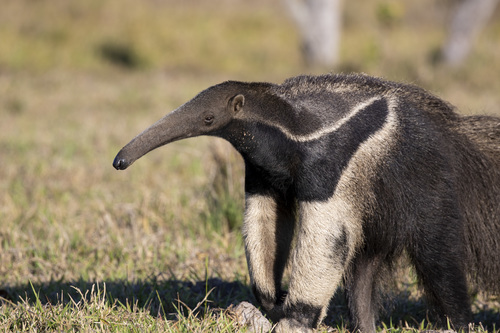
Giant Anteater
The giant anteater, with its long snout and bushy tail, roams Central and South American grasslands. It’s a toothless marvel, using a sticky tongue to feast on ants and termites. This solitary creature plays a vital role in controlling insect populations, making it an ecological keystone.
9-20 years
Lifespan
18.0 - 40.0 kg
Weight
Length: 90 - 210 cm
Size
Brown, Grey, Black, Tan
Color
18 mph
Top Speed
Vulnerable
Conservation Status
Decreasing
Population Trend
Characteristics
The Myrmecophaga tridactyla, commonly known as the giant anteater, is native to Central and South America. It is distinguished by its elongated snout, bushy tail, and powerful claws, used for breaking into ant and termite mounds. Despite its size, it has no teeth and relies on a long, sticky tongue to capture prey.
Distribution Range of the Giant Anteater
Myrmecophaga tridactyla, commonly known as the giant anteater, is native to Central and South America. Its geographical distribution extends from Honduras in Central America down to northern Argentina in South America. The species is found in a range of countries within this region, including Brazil, Paraguay, Bolivia, and Venezuela.
Giant Anteater's Habitat
Environmental Conditions
The giant anteater inhabits a variety of environments, including grasslands, savannas, and rainforests. It prefers areas with abundant ants and termites, its primary food sources. The species is often found in wetlands and flooded grasslands, as well as dry forests and scrublands. The typical climate in these regions ranges from tropical to subtropical, with seasonal variations in precipitation.
Ecological Niche
The giant anteater occupies a specialized ecological niche as a myrmecophagous (ant and termite-eating) mammal. It plays a crucial role in controlling insect populations, primarily feeding on ants and termites using its long tongue and powerful claws to break into insect nests. Its adaptations for this diet include a long, sticky tongue and a robust forelimb structure for digging. The species is generally solitary and has large home ranges, which are necessary to find sufficient food resources.
Copyright @ Nature Style Limited. All Rights Reserved.
 English
English